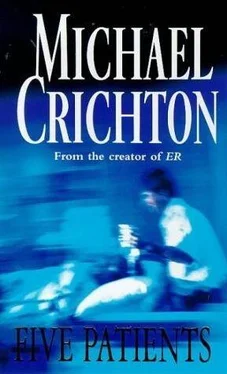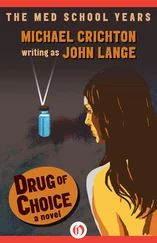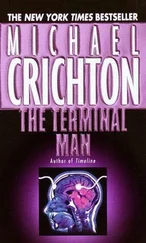Michael Crichton - Five Patients
Здесь есть возможность читать онлайн «Michael Crichton - Five Patients» весь текст электронной книги совершенно бесплатно (целиком полную версию без сокращений). В некоторых случаях можно слушать аудио, скачать через торрент в формате fb2 и присутствует краткое содержание. Жанр: Триллер, на английском языке. Описание произведения, (предисловие) а так же отзывы посетителей доступны на портале библиотеки ЛибКат.
- Название:Five Patients
- Автор:
- Жанр:
- Год:неизвестен
- ISBN:нет данных
- Рейтинг книги:5 / 5. Голосов: 1
-
Избранное:Добавить в избранное
- Отзывы:
-
Ваша оценка:
- 100
- 1
- 2
- 3
- 4
- 5
Five Patients: краткое содержание, описание и аннотация
Предлагаем к чтению аннотацию, описание, краткое содержание или предисловие (зависит от того, что написал сам автор книги «Five Patients»). Если вы не нашли необходимую информацию о книге — напишите в комментариях, мы постараемся отыскать её.
Five Patients — читать онлайн бесплатно полную книгу (весь текст) целиком
Ниже представлен текст книги, разбитый по страницам. Система сохранения места последней прочитанной страницы, позволяет с удобством читать онлайн бесплатно книгу «Five Patients», без необходимости каждый раз заново искать на чём Вы остановились. Поставьте закладку, и сможете в любой момент перейти на страницу, на которой закончили чтение.
Интервал:
Закладка:
These in turn largely reflect the increased technological capacity of the hospital. Mr. O'Connor's example is a case in point: most of the tests performed on him were not available in 1925, when he could have had his room for one twenty-fifth of what it cost him today. The maintenance of this new technological capability costs money-and to a large extent, in medicine as in education, law enforcement, sanitation, and a variety of other services, you get what you pay for. If you are going to enter a high-quality acute-care facility that has six employees (most of them non-physicians) for every patient, and if you are going to pay these employees a decent wage, then your care will be expensive [All this is sometimes easier to see if it is taken out of the hospital setting. If a man had to hire six secretaries for an eight-hour day, at $2.50 an hour, it would cost him $120.00 a day. If a man had to hire two gardeners at $4.00 an hour, for a single eight-hour day, it would still cost him $64.00 a day]. If you are going to purchase technological hardware, maintain it, and keep it up to date, this costs money. If you are going to keep the hospital in continuous operation twenty-four hours a day, three hundred sixty-five days a year, this costs money.
All this becomes clear in the instance of a simple procedure such as a chest X ray. A private radiologist in his office will perform this for you at one half or one third of what the hospital charges. His charge largely reflects the fact that his unit can operate on an eight-hour day and a forty-hour week; other costs, such as equipment and supplies, are the same. In medicine today-as in every other industry-people are more expensive than anything else. Sixty-three per cent of the hospital budget now goes to the salaries and benefits of employees. And much of the rise in hospital costs is directly attributable to the demand of these employees that they not be personally forced to subsidize the health business by accepting wages incommensurate with similar jobs in other industries. Their demands are justified; most employees are still underpaid. Their salaries will increase in the future.
One cannot, however, fairly claim that hospitals are superbly efficient. Especially in a teaching hospital, attention to cost in the medical, non-hotel sector is less central than one would like it to be. One can argue about whether too many tests are ordered, and the argument can continue endlessly. But certainly, when physicians who order these tests don't know what patients are charged for them, eyebrows must go up. In general, doctors tend to operate on a "spare no expense" philosophy which will, eventually, need to be tempered.
But, more fundamentally, the present cost structure of the hospital seems to lead to a rather old-fashioned conclusion: no one should go there unless he absolutely has to.
If a diagnostic procedure can be done on an ambulatory, out-patient basis, it should be; if a series of tests and X rays can be done outside the hospital, they should be. No one should be admitted unless his care absolutely depends upon being inside the hospital; no one should be admitted unless he requires the hour-to-hour facilities of the house staff, the nursing staff, and the laboratories.
For decades, admission to the hospital was necessary because there was no other facility available. For a large segment of the population, care was either given in the hospital, or not at all; and the hospital's clinic system was a poor compromise, with hordes of patients being brought in to wait hours-sometimes literally days-to have relatively brief tests performed.
There is hope that the satellite clinics will help solve the problem; one study of a satellite clinic in Boston reported that there were fewer hospital admissions as a result of the clinic's work.
In any case, alternative facilities must be found, because it is unlikely that hospital costs will ever go down. The best anyone can hope to do in the foreseeable future is to stabilize them somewhere in the neighborhood of $100.00 a day. This makes the hospital an expensive place-but it has its uses, and indeed will be an economically tolerable place, if it is used appropriately.
Peter Luchesi. Surgical Tradition
At 3:15 p.m., the emergency ward was notified that a patient was being transferred in from an outlying hospital: a young man with a nearly severed arm resulting from an industrial accident.
He arrived an hour later and was seen first by Dr. Hopkins, the triage officer, who ordered him sent to OR 1. The surgical residents, Drs. Eugene Appel and Terry Mixter, were called to examine the new patient.
He was twenty-two years old, of medium height and muscular build, looked quite pale, and was speaking weakly. His left hand was bandaged and splinted. An intravenous line had been inserted in his right arm, but it had infiltrated. There was also a bandage over his chin. The bandages were removed and a new intravenous line started. He had a moderately deep two-inch laceration in his chin; the medical student, Sue Rosenthal, was called to suture it. Meanwhile, Appel and Mixter turned their attention to the injured arm.
Three inches above the left wrist the forearm had been mashed. Bones stuck out at all angles; reddish areas of muscle with silver fascial coats were exposed in many places. The entire arm above the injury was badly swollen, but the hand was still normal size, although it looked shrunken and atrophic in comparison. The color of the hand was deep blue-gray.
Carefully, Appel picked up the hand, which flopped loosely at the wrist. He checked pulses and found none below the elbow. He touched the fingers of the hand with a pin and asked if Luchesi could feel it; results were confusing, but there appeared to be some loss of sensation. He asked if the patient could move any of his fingers; he could not.
Meanwhile the orthopedic resident, Dr. Robert Hussey, arrived and examined the hand. He concluded that both bones in the forearm, the radius and ulna, were broken, and suggested the hand be elevated; he proceeded to do this.
Outside the door to the room, one of the admitting men stopped Appel. "Are you going to take it, or try to keep it?"
"Hell, we're going to keep it," Appel said. "That's a good hand."
The patient was started on two grams of cephalothin antibiotic intravenously, and was given more tetanus toxoid. He had received pain medication at the other hospital, and so far had not requested more.
As a workmen's compensation case, the operation would be done by private surgeons: Dr. Hugh
Chandler for orthopedics, Dr. Ashby Moncure for general surgery. At 5:15, Moncure arrived and looked at the hand, satisfied himself that it was indeed viable, and put the patient on call for the operating room. He also called Chandler and summarized the case: "It's a circumferential crush injury to the left hand with compound fracture of both radius and ulna. Innervation and arterial supply look pretty good."
Meantime, the portable X-ray machine was brought in to take a chest film, and two views of the injured hand. The medical student finished suturing the chin laceration. Moncure came back to check that a sample had been sent to the blood bank. He then went off to try to hasten scheduling for the operating room.
At 5:30, the patient complained for the first time of pain in his hand. The surgeons were debating what pain medication to give him when a nurse came in to say the patient was on call to the OR and would get pre-operative medication. He received atropine, Nembutal, and Demerol, which settled the question of pain medication.
Dr. Hussey, looking at the now-elevated hand, concluded that it appeared a little better; the color had improved. He wrapped the injured area in soft gauze, and went off to the X-ray unit to examine the films. He went directly to the residents' reading room, a cubicle with lighted, frosted glass walls for examining X rays. The resident was busy reading other films; Hussey went back into the developing room, past signs which forbade him to do so, to get Luchesi's films. A female technician scolded him; he said he was in a hurry.
Читать дальшеИнтервал:
Закладка:
Похожие книги на «Five Patients»
Представляем Вашему вниманию похожие книги на «Five Patients» списком для выбора. Мы отобрали схожую по названию и смыслу литературу в надежде предоставить читателям больше вариантов отыскать новые, интересные, ещё непрочитанные произведения.
Обсуждение, отзывы о книге «Five Patients» и просто собственные мнения читателей. Оставьте ваши комментарии, напишите, что Вы думаете о произведении, его смысле или главных героях. Укажите что конкретно понравилось, а что нет, и почему Вы так считаете.









